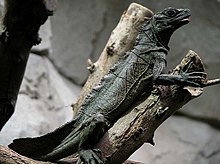Hydrosaurus
| Hydrosaurus | |
|---|---|

| |
| Hydrosaurus amboinensis | |
| Scientific classification | |
| Domain: | Eukaryota |
| Kingdom: | Animalia |
| Phylum: | Chordata |
| Class: | Reptilia |
| Order: | Squamata |
| Suborder: | Iguania |
| Family: | Agamidae |
| Subfamily: | Hydrosaurinae Kaup, 1828 |
| Genus: | Hydrosaurus Kaup, 1828[1] |
| Type species | |
| Hydrosaurus amboinensis | |
| Species | |
| Synonyms | |
| |
Hydrosaurus, commonly known as the sailfin dragons or sailfin lizards, is a genus in the family Agamidae.[2] These relatively large lizards are named after the sail-like structure on their tails. They are native to Indonesia (4 species) and the Philippines (1 species) where they are generally found near water, such as rivers and mangrove.[3] Sailfin lizards are semiaquatic and able to run short distances across water using both their feet and tail for support, similar to the basilisks.[4] They are threatened by both habitat loss and overcollection for the wild animal trade.[3]
In the 19th century, the genus was called Lophura, however in 1903 Poche pointed out that the name was pre-occupied by a genus of pheasants.[5] Since Günther in 1873, the Sulawesi populations were considered to belong to H. amboinensis; Denzer et al. in 2020 resurrected H. celebensis and H. microlophus, increasing the number of species from three to five.[5]
They are the only members of the subfamily Hydrosaurinae.
Species
[edit]There are currently five valid species according to the Reptile Database,[2][3][5]
| Image | Scientific name | Common Name | Distribution |
|---|---|---|---|
 |
Hydrosaurus amboinensis (Schlosser, 1768) | Moluccan sailfin lizard or Amboina sail-finned lizard, soa-soa water lizard | Western New Guinea, Ambon/Amboina Island and Ceram Island (Indonesia) |
 |
Hydrosaurus celebensis (Peters, 1872) | Sulawesi black sailfin lizard | Indonesia (Sulawesi) |
 |
Hydrosaurus microlophus (Bleeker, 1860) | Indonesian giant sailfin dragon,
Makassar sailfin lizard, or Sulawesi giant sailfin dragon |
Indonesia (Sulawesi) |
 |
Hydrosaurus pustulatus (Eschsholtz, 1829) | Philippine sailfin lizard, layagan, balubid, or ibid[6][7] | Philippine archipelago (except Palawan)[8] |
 |
Hydrosaurus weberi Barbour, 1911 | Weber's sailfin lizard | Ternate Island, North Maluku (Indonesia)
Halmahera Island, North Maluku (Indonesia) |
References
[edit]- ^ Hydrosaurus, ITIS report
- ^ a b Hydrosaurus, The Reptile Database
- ^ a b c Cameron D. Siler, Andrés Lira-Noriega, Rafe M. Brown (2014). Conservation genetics of Australasian sailfin lizards: Flagship species threatened by coastal development and insufficient protected area coverage. Biological Conservation 169: 100–108. doi:10.1016/j.biocon.2013.10.014
- ^ Jackman Bauer (2008). Global diversity of lizards in freshwater (Reptilia: Lacertilia). Hydrobiologia 595(1): 581–586.
- ^ a b c Denzer, W.; P.D. Campbell; U. Manthey; A. Glässer-Trobisch; A. Koch (2020). "Dragons in Neglect: Taxonomic Revision of the Sulawesi Sailfin Lizards of the Genus Hydrosaurus Kaup, 1828 (Squamata, Agamidae)". Zootaxa. 4747 (2): 275–301. doi:10.11646/zootaxa.4747.2.3. PMID 32230109. S2CID 214748049.
- ^ "Third Quarter Topical Issue - Philippine Endemic Lizards". PhlPost. 20 July 2011. Archived from the original on 12 December 2013. Retrieved 16 January 2024.
- ^ Hydrosaurus pustulatus, IUCN
- ^ Siler, Cameron D.; Lira-Noriega, Andrés; Brown, Rafe M. (January 2014). "Conservation genetics of Australasian sailfin lizards: Flagship species threatened by coastal development and insufficient protected area coverage". Biological Conservation. 169: 100–108. Bibcode:2014BCons.169..100S. doi:10.1016/j.biocon.2013.10.014.
 Data related to Hydrosaurus at Wikispecies
Data related to Hydrosaurus at Wikispecies Media related to Hydrosaurus at Wikimedia Commons
Media related to Hydrosaurus at Wikimedia Commons- Hydrosaurus, ZipCodeZoo.com
Page Template:Asbox/styles.css has no content.
